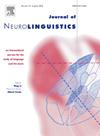Advances in bilingualism as a dynamic process: 30 years of exploration in bilingual mind and brain
IF 1.2
3区 心理学
Q2 LINGUISTICS
引用次数: 0
Abstract
Since Grosjean (1992) and other colleagues proposed bilingualism as a dynamic and interactive process, the field has advanced significantly, enabled by both theoretical developments in bilingual studies and technological innovations. This article is focused on bilingualism research as a highly interdisciplinary enterprise along with the impacts that other fields have had to advance it, in the past and for the future. Behavioral and neurocognitive evidence has shown the broad consequences of bilingualism on human behavior and brain architecture beyond cognition. In addition, recent neurocognitive work using cutting-edge data analytics has demonstrated shared and unique neural correlates of bilingual language representation and processing in humans and machines, spanning from lexical processing to discourse comprehension. Furthermore, emerging technologies have been found to enhance second language learning by providing virtual embodied environments that stimulate learning and motivation. We conclude that interdisciplinary approaches have empowered researchers to gain deeper insights into the dynamic and interactive nature of bilingualism, and we call for continued joint efforts in the study of the bilingual mind and brain in this new era of AI and digital technologies.
动态过程的双语研究进展:双语思维与大脑的30年探索
自从格罗斯让(1992)和其他同事提出双语是一个动态和互动的过程以来,双语研究的理论发展和技术创新使该领域取得了显著进展。这篇文章的重点是双语研究作为一个高度跨学科的事业,以及其他领域在过去和未来对它的影响。行为和神经认知的证据表明,双语对人类行为和大脑结构的广泛影响超越了认知。此外,最近使用尖端数据分析的神经认知工作已经证明了人类和机器的双语语言表征和处理的共享和独特的神经相关性,从词汇处理到话语理解。此外,新兴技术已经被发现通过提供虚拟的具体化环境来促进第二语言学习,从而刺激学习和动机。我们的结论是,跨学科方法使研究人员能够更深入地了解双语的动态和互动性,我们呼吁在人工智能和数字技术的新时代继续共同努力研究双语思维和大脑。
本文章由计算机程序翻译,如有差异,请以英文原文为准。
求助全文
约1分钟内获得全文
求助全文
来源期刊

Journal of Neurolinguistics
医学-神经科学
CiteScore
3.90
自引率
5.00%
发文量
49
审稿时长
17.2 weeks
期刊介绍:
The Journal of Neurolinguistics is an international forum for the integration of the neurosciences and language sciences. JNL provides for rapid publication of novel, peer-reviewed research into the interaction between language, communication and brain processes. The focus is on rigorous studies of an empirical or theoretical nature and which make an original contribution to our knowledge about the involvement of the nervous system in communication and its breakdowns. Contributions from neurology, communication disorders, linguistics, neuropsychology and cognitive science in general are welcome. Published articles will typically address issues relating some aspect of language or speech function to its neurological substrates with clear theoretical import. Interdisciplinary work on any aspect of the biological foundations of language and its disorders resulting from brain damage is encouraged. Studies of normal subjects, with clear reference to brain functions, are appropriate. Group-studies on well defined samples and case studies with well documented lesion or nervous system dysfunction are acceptable. The journal is open to empirical reports and review articles. Special issues on aspects of the relation between language and the structure and function of the nervous system are also welcome.
 求助内容:
求助内容: 应助结果提醒方式:
应助结果提醒方式:


